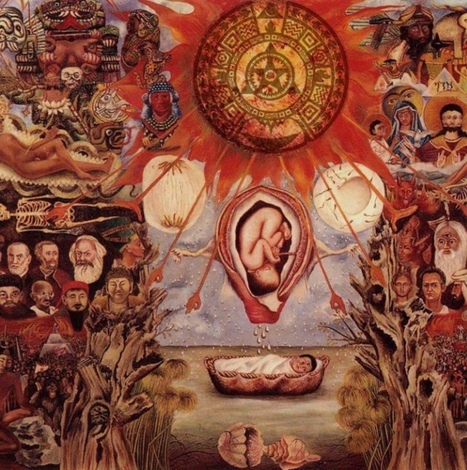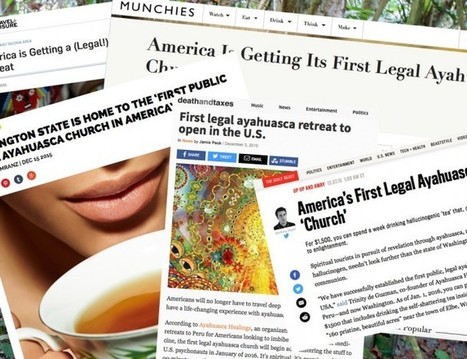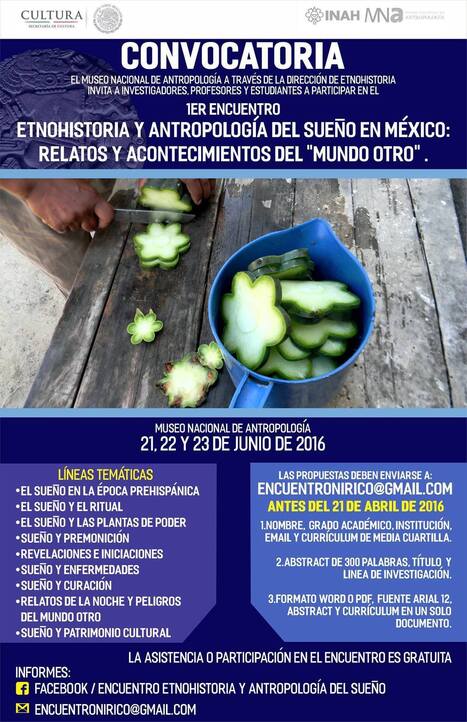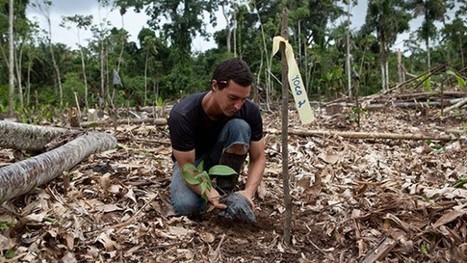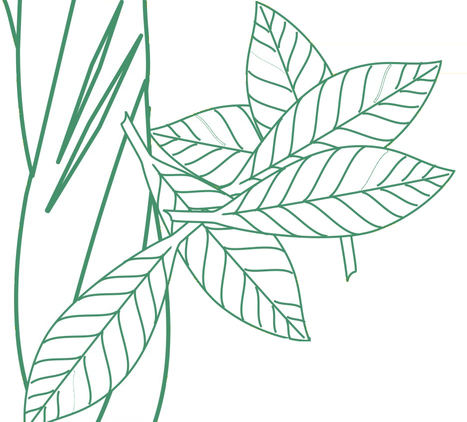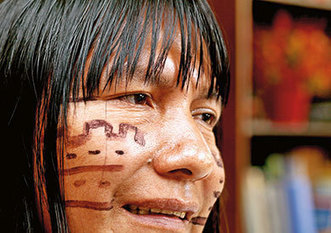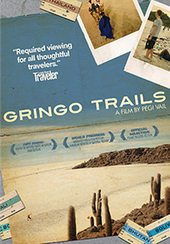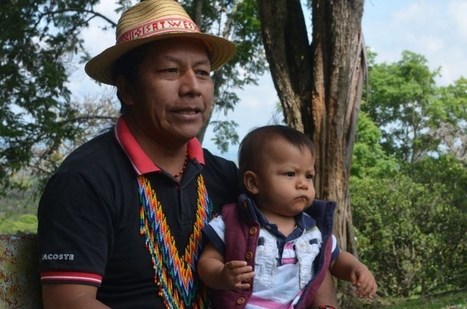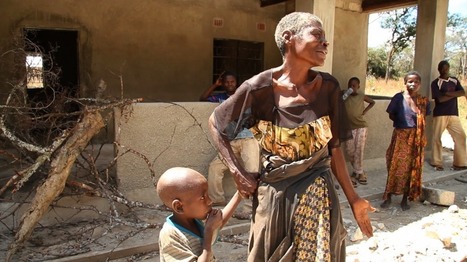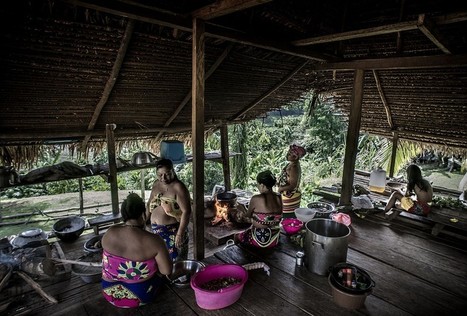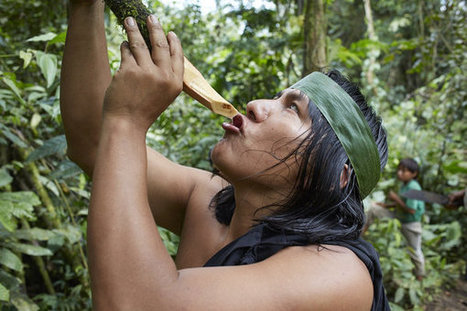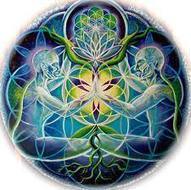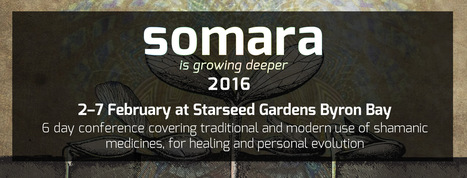 Your new post is loading...
 Your new post is loading...
Back in the early 1990s, when I was doing fieldwork for a book that eventually became The Channeling Zone, I was invited to an ayahuasca healing session in Santa Fe. I had seen enough ayahuasca consumed in northeastern Peru to think that the prospect of full-on emesis and purgation in the house of some stranger…
In 1953 Fanon moved to Algeria to work in the small town of Blida, about 50 miles from the capital Algiers. He applied for a position as a psychiatrist, having recently qualified. Fanon did not leave France for Algeria because he predicted the future publishing success of The Wretched of the Earth, or that a war and revolution against France was about to break out. Algeria transformed Fanon. At the large hospital in Blida he experimented with therapies that he had seen at Saint Alban and developed with the Spanish revolutionary psychiatrist François Tosquelles. After 1954 the hospital was quickly drawn into the war.
If you were on Facebook or any of the many alternative media outlets that reported it last month, you have probably seen stories stating that taking ayahuasca in a legal “church” setting is now possible here in the United States. But is it true? Is it legal? Is it even a church? What exactly is going on here? Reset investigates…
This book focuses on peyote (Lophophora williamsii), a hallucinogenic cactus containing mescaline, which
grows naturally in Mexico and southern Texas. Mescaline is an internationally controlled substance, though exemptions have been made for the religious use of peyote by indigenous groups in Mexico, and by the pan-indigenous Native American Church with chapters in both the United States and Canada. Currently, natural populations of peyote are in decline, due both to improper harvesting techniques (by licensed and non-licensed harvesters) and environmentally damaging economic activities (mining, agriculture, growing cattle, oil developments). In Mexico, peyote is considered a species requiring “special protection” due to environmental concerns; peyote is also protected under the Convention on the International Trade in Endangered Species (CITES) as a species liable to become endangered. This collection addresses the delicate relationship between “the needs of the plant” as a species and “the needs of man” to consume the species for spiritual purposes. The chapters also discuss the history of peyote regulation in the United States and the special “trust responsibility” relationship between the American Indians and the government. Under the argument of “equal protection,” different groups have attempted to obtain an exemption for peyote use. As is the case with conservation, multiple stakeholders’ interests are in conflict. The discussion and comparison of diverse legal cases touch upon concepts such as place, ethnicity, identity, and tradition. The expansion of the peyote traditions is used here as a foundation for examining issues of international human rights law and protections for religious freedom within the current prohibitionist system and global milieu of cultural transnationalism. Collectively, this book offers a unique contribution by presenting a dense anthropological description of peyote use in different contexts, and addressing contemporary conservation and legal issues surrounding peyote and its religious use.
Table of Contents
1. Decline of the genus Lophophora in Texas
Keeper Trout and Martin Terry
Peyote's past and future are interwoven with the history of humans in Texas but how much do we know about the past and future of peyote as a species? Using a multidisciplinary look at the factors involved in the creation of modern Lophophora habitat in Texas, Trout & Terry explore the potential impact of climate change, environmental shifts, dynamic ecosystems, post-glacial flooding, the origin of the Peyote Gardens and recombinant events on creating the present-day view of Lophophora in Texas. In doing so we explore the possible past and future of peyote.
2. An overview of cacti and the controversial peyote
Mariana Rojas-Aréchiga & Joel Flores
In this chapter, we offer a general view of the family to which peyote belongs and some biological, historical and ethnobotanical information about this unique cactus. Cacti are a group of plants included in the cactus family or Cactaceae, being one of the most diversified plant groups, with approximately 1,450 species. They naturally occur in the New World from Canada to Argentina, including the Caribbean. A number of physiological and anatomical adaptations of the shoot and root system enable most cacti to survive and flourish in water-limited environments. Mexico harbors the greatest richness of cacti in the world, with 660 species. Arid and semi-arid regions of the country, mainly the Chihuahuan Desert, the Sonoran Desert, and the Tehuacán Valley, have the greatest concentration of cacti species and several endemisms. Ethnobotanical studies have documented 118 cacti species utilized by indigenous peoples, and one of these is the peyote, widely adopted for its therapeutic and visionary properties. Used since pre-Hispanic times, this species has always been controversial; to some it was considered the devil´s plant, and to others, the gods’ plant. Peyote has been the most important hallucinogenic plant used in North America, and has obsessed not only scientists, but also writers and enthusiasts. Unfortunately, due to overgrazing, seizures, and land use change, wild populations of this plant have decreased. This paper charters the ecological studies on the plant, and tries to highlight the need for more ecological studies to assess its current state of conservation.
3. Peyote in the Colonial Imagination
Alexander Dawson
In 1620, the Holy Office of the Spanish Inquisition banned peyote. After a century in which Spaniards first expressed curiosity about and wonder at the power of the cactus, this edict seemed to consolidate the meanings of peyote within the colonial context. Peyote was dangerous, sinful, and illicit; largely because its users had a different kind of relationship to this plant than they did to other medicinal herbs. Peyote could produce visions of the future, knowledge about the past, and encounters with devils. And yet, this edict did relatively little to settle the meanings of peyote within colonial society. As two centuries of Inquisitorial records indicate, peyote continued to circulate among indigenous and non-indigenous populations throughout the colonial period, and was used towards a variety of spiritual and mundane ends. In examining these records, we have an important opportunity to explore the ways in which the colonial state created and policed its notions of indigeneity and Whiteness through this otherworldly plant. We also see the weakness of that state in its inability to fully keep either its indigenous or non-indigenous subjects within the categories it created.
4. Peyote, Christianity, and Constitutional Law: Towards an Anti-Subordination Jurisprudence
Varun Soni
The history of peyote law in the United States provides a striking example of the centrality of Christianity within the American legislative and judicial branches. This chapter will examine the role of Christianity in the development of American peyote law by focusing on four historical moments: (1) the institutionalization of peyote law by early Christian missionaries; (2) the development of peyote law; (3) the establishment of the Native American Church; and (4) the United States judiciary’s response to peyotism. Using a framework pioneered by Critical Race Studies, this chapter will further examine how the judiciary can formulate an anti-subordination approach to the Free Exercise Clause, an approach which recognizes, preserves, and protects religious practices by carving out a constitutionally protected autonomous space for religious minorities.
5. State and Federal Legal Protections for Peyote Use in the United States
John Forren
Perhaps ironically, legal protections for religious users of peyote have greatly expanded in the United States in the wake of the U.S. Supreme Court’s landmark ruling in Employment Division v. Smith (1990). Smith itself – in denying First Amendment religious exemptions from criminal prohibitions on peyote – was unquestionably a short-term defeat for the cause of Native American religious freedom. Nonetheless, now two decades later, the more important legacy of that Supreme Court decision is the expansive patchwork of statutory and judicially crafted protections for religious peyote use that the political backlash to Smith has helped to create. This chapter traces the development of these post-Smith legal protections for peyotism, focusing specifically on how Native American leaders and their political allies mobilized federal and state policymakers to enact new legal safeguards in the wake of the Supreme Court’s 1990 evisceration of constitutional protections. Early assessments of Smith, the chapter shows, significantly overestimated the U.S. Supreme Court’s authority as the ‘final’ institutional voice on the scope of religious liberty in America. What’s more, such assessments also vastly underestimated both the depth of Americans’ commitment to core principles of religious autonomy and the ability of religious minorities to secure legal protections through coordinated political action.
6. Peyote, Conservation & Indian Rights in the United States
Kevin Feeney
While protections for religious peyote use in the U.S. currently stand on the strongest legal foundation they ever have, the peyote religions currently face a much greater threat than criminal prohibition. Due to land and economic developments in southern Texas (where peyote is harvested commercially), harvesting pressures, and to the harmful harvesting practices employed by some pickers, concern is mounting that peyote may soon become endangered. This chapter explores the conflict between Native American peyote use, the underlying religious rights protecting this practice, and the Endangered Species Act (ESA). Conflicts between federal protections for eagles and the religious use of eagle feathers are examined in order to illustrate how religious use of peyote might be balanced against conservation should peyote become a protected species. In contemplation of a potential ESA listing for peyote several potential avenues for simultaneously protecting peyote and its religious use are considered, with a particular emphasis on cultivation, in the interest of preventing further government restrictions on peyote.
7. Protecting the Medicine for Future Generations: The American Indian Religious Freedom Act Successes, Challenges, and Paths Forward
Bob Prue
The Native American Church has endured over a century of targeted oppression and, with the successes gained due to the American Indian Religious Freedom Act, has emerged in the 21st century as the largest indigenous spiritual movement in North America. Having survived the threats to Euro-American-centric religious ideas and racism, the Native American Church now faces challenges owing to its success. Wild stocks of their sacramental cactus peyote are declining and members see solutions from several sources: establishing environmental protections for peyote and peyote growing regions; creating a mechanism to allow for the legal importation of peyote from areas with more robust stocks in Mexico; and clarification of legal and intra-cultural ambiguity regarding assuring a sustainable supply through horticultural means such as wild-crafting, greenhouse cultivation, or farming. This chapter includes the opinions and recommendations of individuals who are in leadership positions within the Native American Church at chapter, regional, and national levels.
8. Peyote and Psychedelics on the Canadian Prairies
Erika Dyck
Peyote is not native to the Canadian prairies but was introduced to the region in the early 20th century as part of the rituals associated with the Native American Church. Its appearance in western Canada coincided with a growing local interest in psychedelic psychoactive substances and their use in psychiatry, alongside changes in governmental attitudes towards indigenous healing and spiritual practices. In this context, advocators, scientists and government officials in the 1950s became locked in a debate over the genuine value of peyote. Our paper relies on a collection of unpublished papers from sympathetic peyote users in the region to explore the Canadian dimension of an international discussion over the spiritual value of peyote for Canadian Aboriginal people. It examines the introduction of the Native American Church in Canada and explores its adaptation of peyotism, its rituals, spiritual interpretations, and religious discourse, as an imported practice.
9. From Solid To Foamy: Peyote Uses in the Holy Week Rituals of Coras and Huichols in Northwest Mexico
Maria Benciolini and Arturo Gutiérrez
The aim of this paper is to comparatively analyze the use of peyote in the Holy Week festivities celebrated by two indigenous people: the Cora (náayeri) and the Huichol (wixaritari). In both cultures, the power of Father Sun is celebrated during Holy Week, and in both, peyote is ritually consumed by the participants; however, the cactus is used in different contexts and in ways that highlight the distinct concerns and interests of each people. If we can observe a prevalence of solar aspects and a bright side in Huichol ritual, in contrast, the Coras show great interest in the transgressive aspect of aquatic forces. The different concerns of both people are also reflected in the different use of peyote. Many researchers have extensively studied the use and role of peyote in Huichol culture; today it is one of the elements that identify Huichol culture both nationally and internationally. Although the use of peyote is especially visible among the Huichol (partly for legal reasons), it is noteworthy that among the Cora, who share important cultural traits with the Huichol, this cactus is also ceremonially consumed, though not as visibly. For this reason, it is important to generate a shared reflection on the use of the cactus between these two groups.
10. New Age Tourism in Wirikuta: Conflicts and Rituals
Vincent Basset
This chapter provides an ethnographic study of contemporary rituals of peyote in Mexico. Taking as an example the study of tourist activities in the Natural and Sacred Wirikuta Reserve, located in the state of San Luis Potosi, Mexico, it is argued that national and international tourists try to approach Amerindian otherness by means of the practice of a modern form of shamanism. This neo-shamanism, based on a re-appropriation of the local shamanic universe by European imagination, reveals an original way to represent and think about our relation to the Indians and their sacred plants. Tourist activities that re-build new shamanic rituals of peyote consumption have generated many conflicts between native Indians (Wixarica), locals, and drug policy agents in this natural reserve. This study will help us understand the differences in the use of peyote between foreigners and natives, and the resulting cultural impact of this new form of shamanism.
11. Challenges for Peyote Regulation in Mexico: Drug Conventions and Environmental Laws
Beatriz Caiuby Labate & Kevin Feeney
This paper analyzes the history of regulation of the peyote cactus (Lophophora williamsii) in Mexico. First, it examines the discourse that surrounded the establishment of the international drug conventions, with a particular emphasis on the 1971 UN Convention. In discussions leading up to this Convention, preservation of traditional use of peyote in North America was debated. In the Convention’s final form, a mechanism to exempt traditional use of psychoactive plants was included, and Mexico, Canada, and the United States each took advantage of this exemption in order to preserve traditional use of peyote within their respective territories. In 1984, peyote was added to Mexico’s national list of controlled substances, and, in 2009, an exemption was introduced to protect traditional indigenous uses of peyote. Independent of criminal law, peyote is also subject to environmental regulations and protections. Here, we examine the national drug laws, environmental legislation, and the mechanisms through which exemptions to indigenous groups are given. We also provide a brief overview of legal cases involving peyote. We conclude by focusing on the overall challenges, paradoxes, and ambiguities present in the current regulatory framework addressing possession and use of peyote.
12. Why Should Peyote be Valued as Biocultural National Heritage of Mexico?
Mauricio Genet Guzmán Chávez
This chapter reflects on the contemporary use of peyote (Lophophora williamsii) among indigenous and non-indigenous people in Mexico from the heritage point of view. It suggests that the Mexican State should declare peyote as national cultural heritage, in the same way that Peru has done with ayahuasca and the coca leaf. It is argued that the Cactaceae is both emblematic of semi-arid ecosystems in general, and of the Sacred Site of Natural Huiricuta, in particular. Further, the heritage value of the plant lies in its quality as a reservoir and source of knowledge, skills, and practices involving the body, health, and spirituality. The chapter dedicates some attention to the illegal looting of Cactaceae in the Chihuahuense desert and suggests different ways to consider a complete model of conservation and cultural use of the peyote in Mexico.
Editors
Beatriz Labate has a Ph.D. in Social Anthropology from the State University of Campinas (UNICAMP), Brazil. Her main areas of interest are the study of psychoactive substances, drug policy, shamanism, ritual, and religion. She is Professor at the Center for Research and Post Graduate Studies in Social Anthropology (CIESAS), in Guadalajara, Mexico. She is also co-founder of the Nucleus for Interdisciplinary Studies of Psychoactives (NEIP), and editor of NEIP’s website (http://www.neip.info). She is author, co-author, and co-editor of thirteen books, one special-edition journal, and several peer-reviewed articles. For more information, see: http://bialabate.net/
Clancy Cavnar has a doctorate in clinical psychology (PsyD) from John F. Kennedy University. She currently works at a dual diagnosis residential drug treatment center in San Francisco and is a research associate of the Nucleus for Interdisciplinary Studies of Psychoactives (NEIP). She combines an eclectic array of interests and activities as clinical psychologist, artist, and researcher. She has an undergraduate degree in liberal arts from the New College of the University of South Florida, a master of fine arts in painting from the San Francisco Art Institute, a master’s in counseling from San Francisco State University and a certificate in substance abuse counseling from the extension program of the University of California at Berkeley. Her art is inspired by her experience with psychedelics, especially with the Santo Daime religious tradition. She is author and co-author of articles in the Journal of Psychoactive Drugs and the International Journal for Drug Policy, among others. She is co-editor, with Beatriz Caiuby Labate, of six books: The Therapeutic Use of Ayahuasca (Springer, 2014); Prohibition, Religious Freedom, and Human Rights: Regulating Traditional Drug Use (Springer, 2014); Ayahuasca Shamanism in the Amazon and Beyond (Oxford University Press, 2014); Peyote: History, Tradition, Politics and Conservation (ABC-Clio/Praeger, 2016); The World Ayahuasca Diaspora: Reinventions and Controversies (Ashgate, 2016, in press); Drug policies and the politics of drugs in the Americas (Springer, 2016, in press). Clancy's art and academic work has been presented both in the US and abroad. For more information see: http://www.neip.info/index.php/content/view/1438.html and http://www.clancycavnar.com
Authors bio here
Buy here
Versión en español
Lucas Weiss was just another dropout on the gringo trail until he landed among Ecuador's remote Secoya people. Now he's a tribal leader, heir to their revered 103-year-old shaman — and maybe their best hope for survival.
Is it really dangerous to combine some pharmaceutical drugs with Ayahuasca? YES. Unlike food interactions, whose consequences are usually unlikely to be serious, interaction with pharmaceutical drugs and meds (including some over-the-counter drugs and certain herbs) can be potentially life-threatening.. The combination of MAOIs and other serotonin agonists or precursors poses a particularly severe risk of a life-threatening serotonin syndrome episode.
Para llegar a Llanchamacocha tienes que ir hasta Shell (un pueblo al lado de Puyo) y tomar una avioneta que se elevará entre las nubes por veinticinco minutos sobre el Amazonas ecuatoriano. Desde allá arriba verás cómo el corazón de la Tierra parece un gran brócoli que está siendo comido por una interminable boa de agua del color de la tierra, mientras las nubes parecen escalar las verdes montañas. Desde ahí pensarás que las pequeñas casas construidas entre la selva son insignificantes y que no hay soberbia humana capaz de destruir esa infinita vida que brota incesantemente desde cada rincón.
"Las cosas ocurren primero en el mundo espiritual. Los humanos, a través de los sueños, vemos qué es lo que ocurre en ese mundo; y podemos tomar decisiones sobre la base de lo que nos han contado los espíritus mientras dormimos. Hacer o no lo que nos recomiendan es opcional."
A Winnipeg man who admits to killing a British man in self-defence at a retreat in Peru Stevens, 29, after drinking ayahuasca, says he's scared to leave his home and is concerned about a possible trial.
"In late July and early August, I visited my Shipibo Maestro in his native community to do another ten day dieta with Ayahuma. This was possibly the most powerful dieta I have done. In the third of the five ceremonies that constitute a ten day dieta, I experienced a vertical sheet of pain in the right side of my brain. This increased in intensity, until I felt I had to use every ounce of my strength and energy to stop the pain. The idea occurred to me that I was experiencing a stroke and, that if I did not die at that moment, I was destined to die very shortly."
"Are tourists destroying the planet—or saving it? How do travelers change the remote places they visit, and how are they changed? From the Bolivian jungle to the party beaches of Thailand, and from the deserts of Timbuktu, Mali to the breathtaking beauty of Bhutan, GRINGO TRAILS traces stories over the course of thirty years to show the dramatic long-term impact of tourism on cultures, economies, and the environment. A global survey of the impacts on cultures, economies, and the environment of the most powerful globalizing force of our time: tourism."
“Earlier this year, the surviving members of the Grateful Dead played sold-out ‘Fare Thee Well’ concerts in Santa Clara and Chicago to celebrate the 50th anniversary of the foundi…
|
Imprisoned Colombian indigenous leader Feliciano Valencia talks to New Internationalist. Robin Llewellyn reports.
Como sabemos cada día es más fácil asistir a una toma de ayahuasca. Muchas de esas tomas son poco más que estafas new age en las que los asistentes quedan expuestos a los riesgos derivados de un mal diseño de toma y del ambiente que se genera. En su día, a cierto foro, envíe un mensaje en el que invitaba a una serie de reflexiones que facilitaran la identificación del “típico iluminado ayahuasquero” con sus malas praxis y sus estafas. Con ciertas variaciones he rescatado este mensaje. En él figuran una serie de cuestiones a ponderar si es que se nos brinda la posibilidad de asistir a una sesión de ayahuasca. Estas son una serie de indicaciones que, si algo buscan, es invitar a la reflexión y proponer herramientas críticas sobre asuntos diversos. Los experimentos con gaseosa. Respetemos nuestra propia conciencia sabiendo donde nos metemos. De entrada considérese algo. Por cierto, ¿recuerda el lector esas recomendaciones para tomar sustancias y plantas visionarias, sobre el set y el setting, que tanta difusión tuvieron en la época de la contracultura?... Se centraban, básicamente, en la atención al momento que cada cual estuviera atravesando (aconsejando o desaconsejando la ingesta), al entorno y al contexto de experiencia y a las compañías con quienes íbamos a compartir la velada. Bien, muchos de los entornos que, hoy en día, ofrecen ayahuasca incumplen clamorosa y sistemáticamente estas recomendaciones.
If you live and work in Canada, chances are you’re connected to Canadian mining companies – whether you know it or not – through your savings, taxes, Canada Pension Plan contributions, RRSPs and other investments. In We Call Them Intruders, two Vancouver-based filmmakers trace their savings to Canadian mines in Eastern and Southern Africa, unearthing the stories behind some of the continent’s largest Canadian-owned mining projects. The film brings viewers on a journey, taking a hard look at why communities, governments and corporations are so often pitted against each other in an explosive battle over extracting the earth’s riches.
The first step to understand how drug policy works is to understand how policy works. Most people who live close to either drug consumers, traffickers or producers do not understand how policy works. They understand the sense of urgency, the terrible harm that can be avoided if the legal framework applying to those people would improve today. When these people are placed in high level meetings of diplomats where UN Conventions on drugs are discussed – such as UNGASS 2016 – they are entering a world where people hate the word ‘urgency’. Most people coming to these meetings consider them as a career opportunity, and being seen to promote drastic changes is not the best way to improve your perspectives.
I saw a wolf sitting in the black field of my mind, but I still hate myself.
There is a great deal of information about serotonin toxicity in this section. Most people will find understanding this material will be easier if they read the introduction first. The menu on the left-hand side of the screen contains the multiple topic headings, so you can go straight to a particular section if you are looking for specific information and you already understand about serotonin toxicity.
Los Parará Purú se encuentran junto a una de las zonas más estratégica del mundo: la mayor obra de ingeniería civil del planeta, el Canal de Panamá.
In an unlikely collaboration with Amazonian shamans, medical researchers seek a cure for autoimmune disease.
Joshua Stevens sat down with CTV News in Winnipeg for an exclusive interview to share his story of what led to him killing a man at an ayahuasca retreat in Peru.
Desde hace años la situación de la ayahuasca en Europa y más concretamente en el Estado Español, se mantuvo dentro de unos márgenes relativamente estables y controlados. Unas pocas personas con más o menos formación y a título individual ofrecían al gran público Esta planta sagrada. Esta situación ha cambiado radicalmente en los últimos…
Somara 2016 - 6 day conference covering traditional and modern use of shamanic medicines, for healing and personal evolution. This year will include Workshops on the weekdays from Feb 2-5 (with Talks or Panels Discussions in the evenings), Then two full days of Talks and Panel Discussions on the weekend of Feb 6-7; Somara Visionary Art Exhibition curated by Pauli Mann; Market stalls with plants, books, adornment and more; Herbal elixirs and snacks at the Lotus Teahouse and The Starseed Kitchen will be serving Lunches and Dinner on Sat 6 and Sun 7. Early Bird Tickets have been extended to Midnight at the end of Jan 21 (technically 12am Jan 22). Purchase tickets here. Lineup and other announcements happening daily on facebook.com/somara.org 2–7 February, 2016 at Starseed Gardens
Byron Bay, Australia.
ECfES develops and promotes ethnobotanical opportunities through
education and leading edge neuro-science.
We educate through history.
We share knowledge through service.
We develop through science.
And advance towards the future,
by preserving the essence.
And honoring developments.
Today.
|

 Your new post is loading...
Your new post is loading...
 Your new post is loading...
Your new post is loading...



